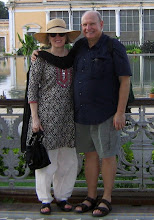Mamallapuram, which I believe means “it’s good to be the ruler” in the archaic Tamil dialect, is located on the Bay of Bengal about 100 kilometers south of Chennai. The area was the seat of power for the eastern lower half of India during the 6th to 9th centuries AD. It appears that the rise of political power came from uniting fairly unorganized tribes who migrated south when the Aryans moved into the northern part of India about 1500 BC. The fact that it took over 2000 years to get organized points directly to the concept of IST or India Stretch Time which we have experienced for the last two months. But considering the time difference, most of our challenges have been overcome in the blink of an eye.
 On our drive down, we did see areas along the way that had been destroyed by the tsunami almost 3 years ago. The small fishing villages had been pretty much destroyed but the fishing boats, many of them at sea, remained intact allowing the economy of the area to continue while life on land was pretty much devastated. The federal government was building permanent housing for the villagers farther inland, adding a degree of difficulty for the fishermen getting to their boats early in the morning.
On our drive down, we did see areas along the way that had been destroyed by the tsunami almost 3 years ago. The small fishing villages had been pretty much destroyed but the fishing boats, many of them at sea, remained intact allowing the economy of the area to continue while life on land was pretty much devastated. The federal government was building permanent housing for the villagers farther inland, adding a degree of difficulty for the fishermen getting to their boats early in the morning.There was a large government project also under construction on the way to Mamallapuram that was desalinization plants to help supply Chennai and the area with more water. Something we should think about in the US as well.
Anyhow, we met our guide Irudhayam, Irud for short, as he stretched himself across the street in front of our vehicle. Rajkumar couldn’t get around him and before you knew it, he was seated in the front passenger seat after a brief negotiation of a fee for the two hours we would be there. As you can imagine, Irud was connected with all the vendors in the shops that lined the path to the government ticket office.
There were the pathetic-looking beggars along the walk as well. However, when you see them try to hide their stainless steel lunch pails, part of the pathos evaporates. There appears to be a symbiosis of all the folks who are supported by the tourist trade here. The nods to one another or a sharp word between our guide and a vendor suggested the system was well mapped out and boundaries were established that one should not cross.
 We started with the complex of temples all carved out of one rock. Each temple had at least one god as the occupant: Shiva being one, Parvati being another, all part of the story which we eventually come to know as the Ramayana. While the artistic quality of the temples have been diminished by weathering, the concepts that the temples represent are complex and integrated suggesting the artists had a plan and the overall work had been created long before the first hammer hit stone.
We started with the complex of temples all carved out of one rock. Each temple had at least one god as the occupant: Shiva being one, Parvati being another, all part of the story which we eventually come to know as the Ramayana. While the artistic quality of the temples have been diminished by weathering, the concepts that the temples represent are complex and integrated suggesting the artists had a plan and the overall work had been created long before the first hammer hit stone.Over the centuries that these various temples were constructed, different styles and different parts of the mythologies became more pronounced. The gods also took different forms, and the stories gained in complexity. Many of the bits and pieces of Hindu mythology that we run into today are portrayed on the various edifices throughout the complex. Note the Chinese influence on this lion below. Definitely speaks to the trading that was going on here during that time.

 Now this Shiva temple was stone-on-stone construction and the mortar that holds it together was a local concoction of lime from seashells, sugar, and other local materials. All these were covered with sand by an ancient tsunami and uncovered by the British about 125 years ago. Now the India Archaeological Survey maintains the sites.
Now this Shiva temple was stone-on-stone construction and the mortar that holds it together was a local concoction of lime from seashells, sugar, and other local materials. All these were covered with sand by an ancient tsunami and uncovered by the British about 125 years ago. Now the India Archaeological Survey maintains the sites.





No comments:
Post a Comment